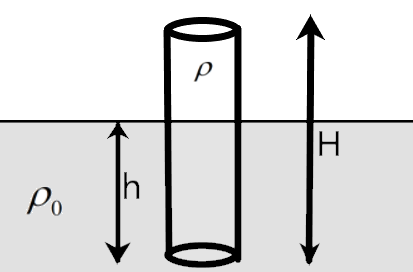Question
Question: A solid cylinder of height H and density \[\rho \] is floating in a non-viscous liquid of density \[...
A solid cylinder of height H and density ρ is floating in a non-viscous liquid of density ρ0 as shown in the figure. IN equilibrium condition a length h of the cylinder is inside the liquid. If it is displaced slightly from that position then the time period of the oscillating cylinder is –

Solution
We need to understand the relation between the force acting on the cylinder and the force due to the mass of the cylinder which cancels off at the equilibrium condition. A displacement will result in the oscillation of the system in the liquid.
Complete step-by-step solution
We know that for an object to be partially immersed in a fluid as per the given situation, the weight due to the mass of the cylinder is balanced by the buoyancy applied by the liquid on the cylinder.

We can give this relation mathematically as –
Feqm=W−B=0
Now, when the cylinder is provided with a small displacement of ‘x’, the buoyancy acting will increase with the mass immersed in the liquid during the oscillation. The buoyant force will be proportional to the volume occupied by the cylinder and the density of the liquid. This can be given as –
Bnew=V.ρ0.g
Where V is the extra volume immersed in the liquid.
Now, the net force acting on the cylinder will be excess due to the buoyancy, which is given as –
